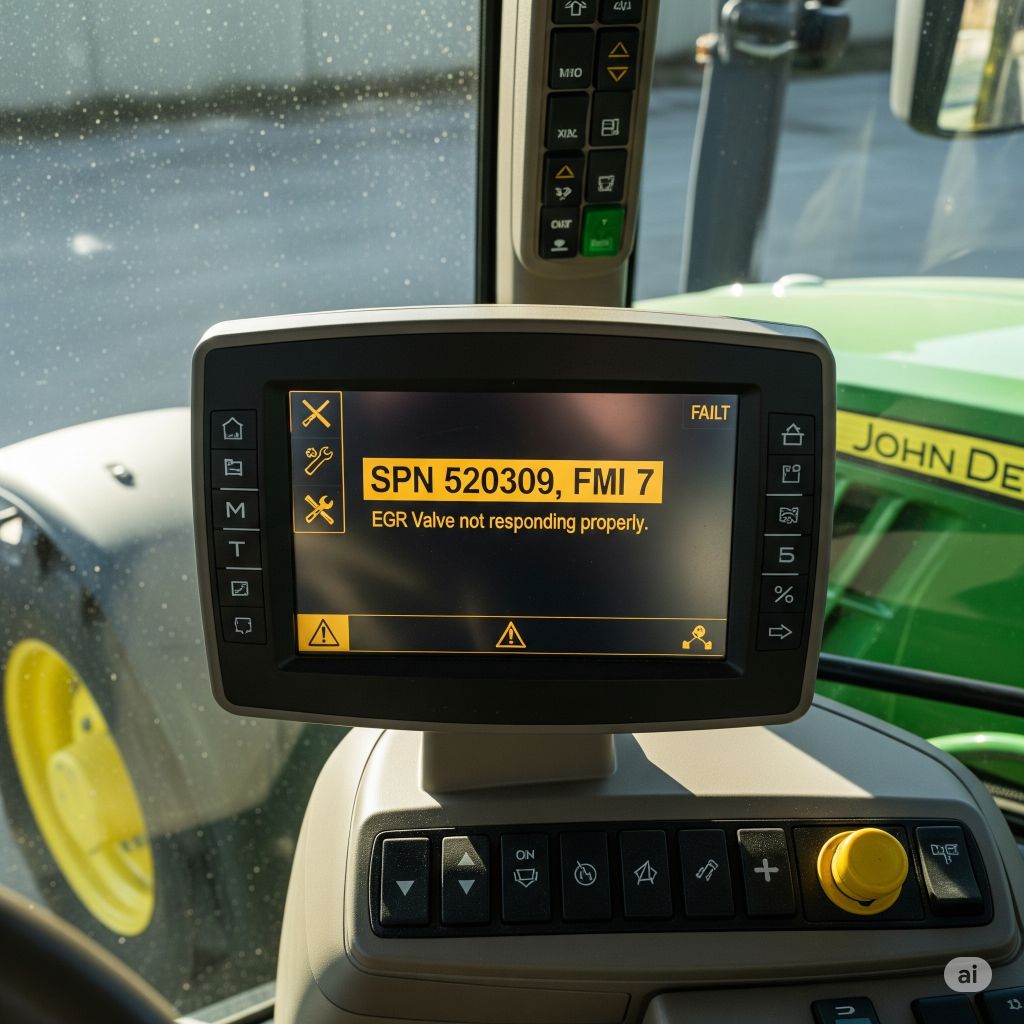
Operating a John Deere tractor involves managing high-tech machinery designed for maximum efficiency, productivity, and safety. Fault codes play a crucial role in this ecosystem, serving as diagnostic tools that help operators, mechanics, and fleet managers identify issues rapidly, minimize downtime, and maintain peak equipment performance.
This comprehensive guide explores John Deere tractor fault codes in depth, including how they work, how to read them, popular codes and their meanings, troubleshooting, and advice on using fault code data for better maintenance outcomes.
Understanding John Deere Fault Codes: What Are They?
John Deere tractors are equipped with multiple electronic control modules (ECMs) and sophisticated sensors. These systems constantly monitor the performance of the tractor’s components—engine, transmission, hydraulics, electronics, and more. When a system sensor detects performance outside of expected parameters, it logs a Diagnostic Trouble Code (DTC), commonly referred to as a fault code.
What Does a Fault Code Represent?
A fault code is typically composed of numerals or alphanumeric sequences. Each section in a code conveys information:
- System Identifier: Indicates which system or control unit reported the issue (e.g., Engine Control Unit “ECU”).
- Function Code: Ties the anomaly to a specific component or sensor.
- Failure Mode Identifier (FMI): Suggests the nature or severity of the problem, such as high voltage, low voltage, open circuit, out of range, etc.
Example
- 1347.4
- 13 = Engine system
- 47 = Fuel pump
- .4 = Low voltage or short circuit
- 1569.31
- 15 = Vehicle system
- 69 = Vehicle Information Control Unit
- .31 = Condition not met
John Deere Control Units and Their Codes
Modern tractors incorporate several control units that generate fault codes. Some of the most common include:
| Prefix | Unit |
|---|---|
| ECU | Engine Control Unit Diagnostic Trouble Codes |
| ACU | Armrest Control Unit |
| CCU | Central Control Unit |
| ICU | Instrument Control Unit |
| HCU | Hitch Control Unit |
| SCU | Selective Control Valve (SCV) Unit |
| BCU | Basic Control Unit |
| CAB | Cab Control Unit |
| IVT | IVT Transmission Control Unit |
| PTQ | PowrQuad Plus Transmission Control Unit |
| TEC | Tractor Equipment Control Unit |
| VLC | Vehicle Load Center Control Unit |
| SFA | Triple-Link Suspension Control Unit |
| SSU | AutoTrac Steering System Control Unit |
How to Identify and Read Fault Codes
Viewing Codes Onboard
Most John Deere tractors have advanced digital dashboards or displays. To retrieve fault codes:
- Hold the Diagnostic Button: Many models require the operator to press and hold a console or steering-column button for about 5 seconds. This will display any active codes on the dashboard.
- Use the Tractor’s Menu System: For M-Series or tractors with a digital display, use the navigation dial or buttons to locate the diagnostics/trouble code menu, where active and stored fault codes are listed.
- Via Diagnostic Tools: For extensive troubleshooting, use a John Deere Service Advisor tool or compatible diagnostic software. Alternatively, some users rely on smartphone apps, entering codes for explanations and troubleshooting.
Interpreting the Display
Once identified, codes need to be cross-referenced with service manuals or official code lists. Knowing the prefix, system number, and mode helps narrow the issue quickly, minimizing guesswork.
Common John Deere Tractor Fault Codes and Meanings
Below is a selection of actual codes, their system, and what they typically mean. Note that actual impact varies depending on the tractor model and configuration.
| Code | System | Typical Meaning |
|---|---|---|
| 1347.4 | Engine System (Fuel Pump) | Low voltage or short circuit |
| 1569.31 | Vehicle System (VICU) | Condition not met |
| 524031.19 | Electrical System | Engine control unit range incorrect |
| 3216.9 | Cooling System (Thermostat) | Incorrect range |
| 524235.05 | CCU (4WD Circuit) | Main Control Module, voltage 4WD circuit error |
| 000096.03 | CCU (Fuel Level Sender) | High voltage at fuel sender |
| 001638.00 | Transmission Hydraulic Oil | Hydraulic oil temperature is very high |
| 003509.04 | CCU (5V Sensor Supply) | Low voltage on the 5V sensor supply circuit |
| 524267.15 | PTR (Shuttle) | Forward/Reverse shuttle performed at high travel speed |
| 000152.12 | ECU (Engine Boot) | Issue with engine ECU when module is booting up |
| 002818.31 | CCU/ICC (Seat Switch) | Operator seat switch not activated with PTO switched on |
| 524021.31 | PTR (Shuttle Lever) | Shuttle lever reverse signal issue |
| 000167.04 | ICC (Battery/Alternator) | Low battery/alternator voltage |
| 003695.14 | ECU (DPF) | Calculated soot loading in DPF is high—regeneration switch is off |
| 524252.05 | CCU (PTO Circuit) | Voltage issue in PTO circuit |
| 000628.02 | Multiple (Boot Issues) | Modules report internal issues during boot sequence |
Fault Code Structure & Explanation
Let’s break down a few fault code examples for clarity:
Sample Code Table
| Code | Detailed Breakdown | Primary System | Common Cause(s) |
|---|---|---|---|
| 1347.4 | 13 (Engine), 47 (Fuel Pump), 4 (Low Voltage) | Fuel System | Damaged wire, sensor or short circuit |
| 524031.19 | 52 (Electrical), 403 (ECU), 19 (Incorrect Range) | Electrical/Engine Unit | Faulty engine control module setting |
| 003695.14 | 3 (Engine), 695 (DPF), 14 (High Soot) | Emissions (DPF) | DPF overloaded, regen disabled |
| 000628.02 | 0 (General), 628 (Module Boot), 2 (Internal Err) | System Boot/General | Software error, memory issue |
| 524267.15 | 52 (Electrical), 426 (Shuttle), 15 (High Speed) | Transmission | Operator executed direction shift too quickly |
Systematic Breakdown of Major Control Unit Code Prefixes
1. Engine Control Unit (ECU) Codes
- Typically start with “ECU”
- Deal with fuel injection, exhaust, air intake, turbocharging, EGR, cooling, and emissions
Common Codes:
- ECU 000157.03 – Fuel rail pressure input voltage problem
- ECU 000412.15 – EGR temperature higher than expected
- ECU 000636.02 – Pump position sensor issue
- ECU 003695.14 – DPF soot loading high, regeneration needed
2. Central Control Unit (CCU) Codes
- Responsible for core tractor configuration and operational communication
- Issues may range from CAN bus errors, memory/configuration faults, or sensor failure
Examples:
- CCU 000096.03 – High voltage at fuel sender
- CCU 001638.00 – Hydraulic oil temperature high
- CCU 524235.05 – 4WD circuit voltage issue
3. Transmission Codes (PTR, IVT, PTQ)
- Cover traditional or IVT transmission, clutch, park/neutral switches, and more
Examples:
- PTR 000084.07 – Wheel speed detected during transmission calibration
- PTR 524234.04 – Issue with enable trans pressure sensor
- PTQ 524267.15 – High-speed direction shuttle event
4. Instrument Control Unit (ICU/ICC)
- Manages dashboard and instrument data
- Monitors voltage, air filter warnings, operator presence, and general alerts
Examples:
- ICC 000107.00 – Engine air filter blocked
- ICC 000167.04 – Low battery/alternator voltage
How to Troubleshoot and Resolve Fault Codes
Step-by-Step Fault Code Troubleshooting
- Identify and Record the Code: Access your diagnostics screen or manual code retrieval method. Note all codes—some tractors can log multiple simultaneous faults.
- Cross-Reference: Consult your operator’s manual, John Deere online resources, or a fault-code reference list.
- Assess Severity: Codes tied to green/yellow amber icons are often advisory, while red codes indicate urgent or critical attention is needed.
- Follow Diagnostic Steps: Some problems can be resolved by resetting the tractor or checking for loose connectors, sensor wires, or blown fuses.
- Consider Environmental Triggers: Sharp temperature changes, heavy moisture, or intensive operation can trigger sensor warnings.
- Address Root Causes: Replace faulty sensors, top up fluids, perform a filter cleaning or DPF regeneration as needed.
- Clear Code: Many codes will clear automatically after the issue is remedied; others may require a diagnostic tool or battery cycle.
Preventive Maintenance: Using Fault Codes Proactively
A fault code is a warning—a chance to prevent breakdowns or expensive repairs. Here’s how to use code reports for proactive maintenance:
- Track Equipment Trends: Regularly check diagnostic logs for emerging patterns.
- Train Operators: Familiarize staff with fault codes and their meanings to enable quicker, safer responses in the field.
- Use Dealer Resources: John Deere dealers can decode, clear, and explain codes with proprietary diagnostic equipment.
- Leverage Apps & Digital Platforms: Apps allow you to log, track, and investigate codes right from a phone or tablet for enhanced fleet management.5
Frequently Asked Questions
Q: Are all faults critical?
A: No. Some fault codes are information-only (e.g., low windshield washer fluid), while others—such as low oil pressure or engine overheating—require immediate attention.
Q: Can I clear codes manually?
A: Minor faults often clear after cycling the ignition or resolving the issue. Persistent or serious codes may need a dealer’s diagnostic tool.
Q: Why does my tractor show multiple codes at once?
A: Faults can cascade—primary failures might trigger secondary codes as related systems are affected. Addressing all displayed codes, especially those marked active, is key.
Q: Are codes model-specific?
A: While many codes are universal, there are differences between E-Series, M-Series, R-Series, as well as utility, specialty, and large ag-line tractors. Always check the manual for your exact model.
Table: Sample John Deere Fault Codes and Their Explanations
| Code | System | Explanation | Action Needed |
|---|---|---|---|
| ECU 000110.00 | Engine | Coolant temperature high | Check coolant level; clean radiator; call dealer if repeat |
| ECU 000157.04 | Engine | Fuel rail pressure input voltage problem | Inspect fuel rail and sensors; call dealer if persists |
| ECU 003695.14 | Engine/DPF | DPF soot level high, regen needed | Set regen switch to auto or perform manual regeneration |
| CCU 524235.05 | 4WD | Voltage issue with 4WD circuit | Inspect electrical/fuse circuit for 4WD |
| PTR 524267.15 | Transmission | Shuttle operation at high speed | Engage F/R shuttle at appropriate speeds |
| ICC 000167.04 | Instruments | Low battery/alternator voltage | Test battery/alternator; check wiring |
| CCU 001638.04 | Hydraulic | Oil temperature sensor low voltage | Inspect/replace sensor; check oil level |
Tips for Using Fault Codes Effectively
- Document Everything: Keep a log of ongoing and historic codes for all tractors in your fleet for better pattern recognition.
- Invest in Diagnostic Tools: Consider purchasing or subscribing to a digital diagnostic tool, especially for large operations.
- Schedule Dealer Checks: Incorporate code review in your regular dealer service appointments—sometimes issues are software-related and unseen to the eye.
Conclusion
John Deere tractor fault codes are integral to maximizing uptime, reducing unnecessary replacement parts costs, and safeguarding productivity. Mastery of these codes will empower you and your team to resolve issues quickly, understand the limits of onboard diagnostics, and facilitate clear communication with service technicians. For the most accurate and detailed troubleshooting, always keep your operator’s/technical manual accessible and engage with official John Deere resources when encountering persistent or complex faults.
By recognizing the codes, understanding the message communicated, and following systematic troubleshooting, you can extend the life and reliability of John Deere tractors, ensuring years of efficient and uninterrupted service.
- https://www.news-jd.com/john-deere-fault-codes-list/
- https://www.epcatalogs.com/blog/john-deere-tractor-error-codes-understanding-and-diagnosing/

I’m David man behind Lawn Mowerly; I’ve been dealing with lawnmowers and Tractors with my father since I was a kid. I know every make and model and what each one is capable of and love helping people find the perfect equipment for their needs.
